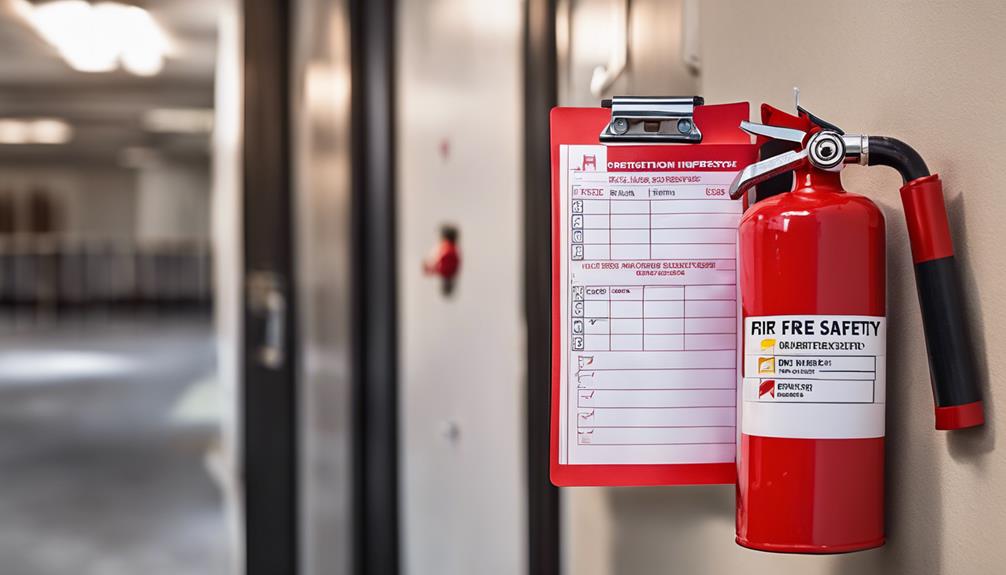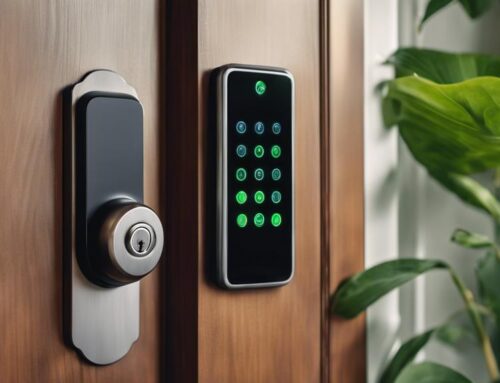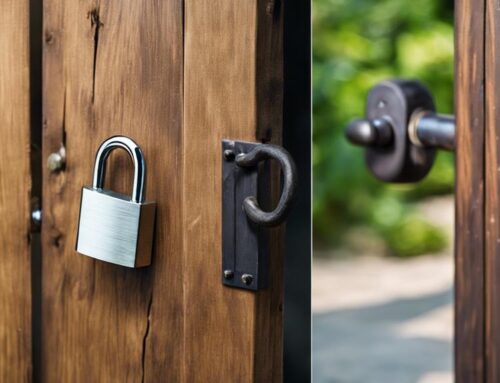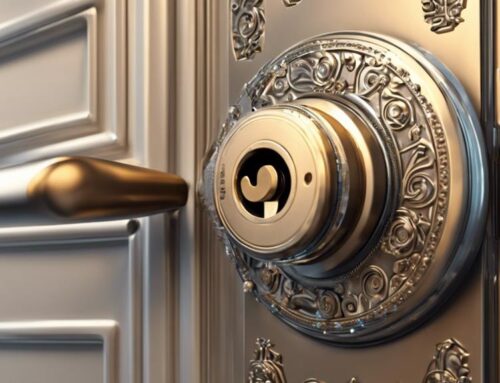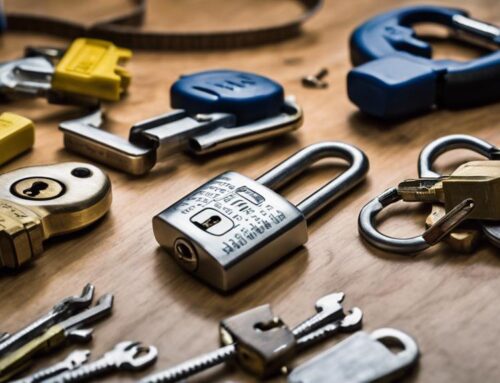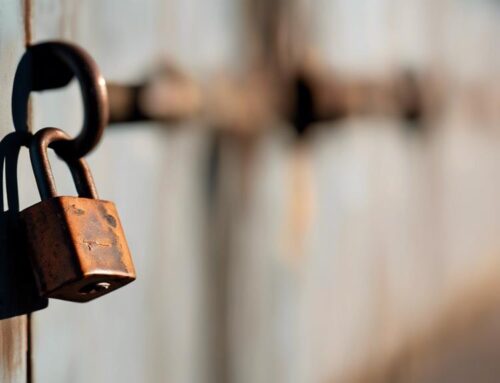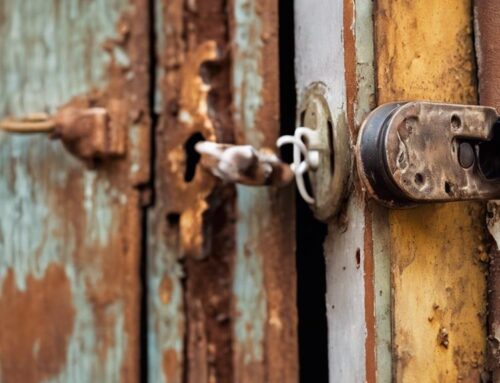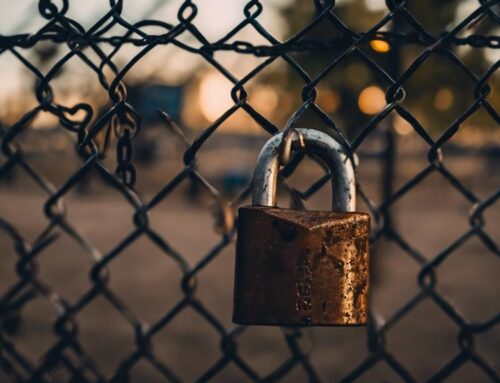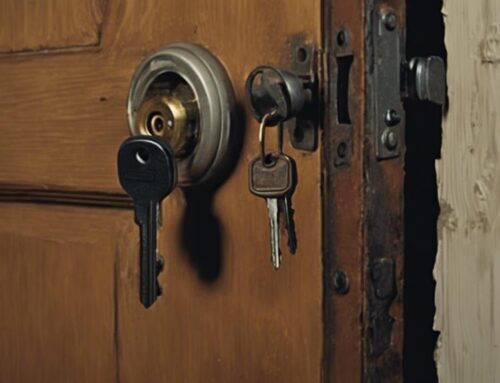Fire safety regulations require you to guarantee that any lock replacements comply with specific standards. This is vital for protecting lives and property during emergencies. You'll want to choose fire-rated locks, as they withstand high temperatures and help keep escape routes clear. Regularly evaluating and replacing outdated locks enhances overall safety. Remember, compliance also protects against legal issues and potential insurance problems. By understanding the types of locks and their features, you can make informed choices that elevate security and safety. Keep exploring to uncover essential information on maintenance and adherence to code requirements.
Key Takeaways
- Fire safety regulations mandate the use of compliant locks to ensure safe and accessible evacuation routes during emergencies.
- Regular assessment and replacement of outdated locks is crucial for maintaining compliance with fire safety standards.
- Fire-rated locks are essential as they limit fire and smoke spread, offering protection for up to 60 minutes.
- Non-compliance with fire safety regulations can lead to legal liabilities, financial penalties, and voided insurance coverage.
- Routine maintenance and inspections of locks and emergency systems are vital for overall building safety and compliance.
Importance of Fire Safety Regulations
Fire safety regulations are essential for protecting lives and property. When you prioritize these regulations, you guarantee that everyone in your building can escape safely in the event of a fire.
One significant element of these regulations includes fire safety lock regulations that dictate the types of locks you should use. By choosing fire code compliant locks, you're not just following the law; you're actively protecting lives.
Fire-rated locks play an important role in limiting the spread of fire and smoke, giving people critical extra minutes to evacuate. You'll find that these locks are designed to withstand high temperatures, providing a barrier that can save lives.
It's important to regularly assess and replace any outdated or non-compliant locks in your facility.
Understanding Lock Standards
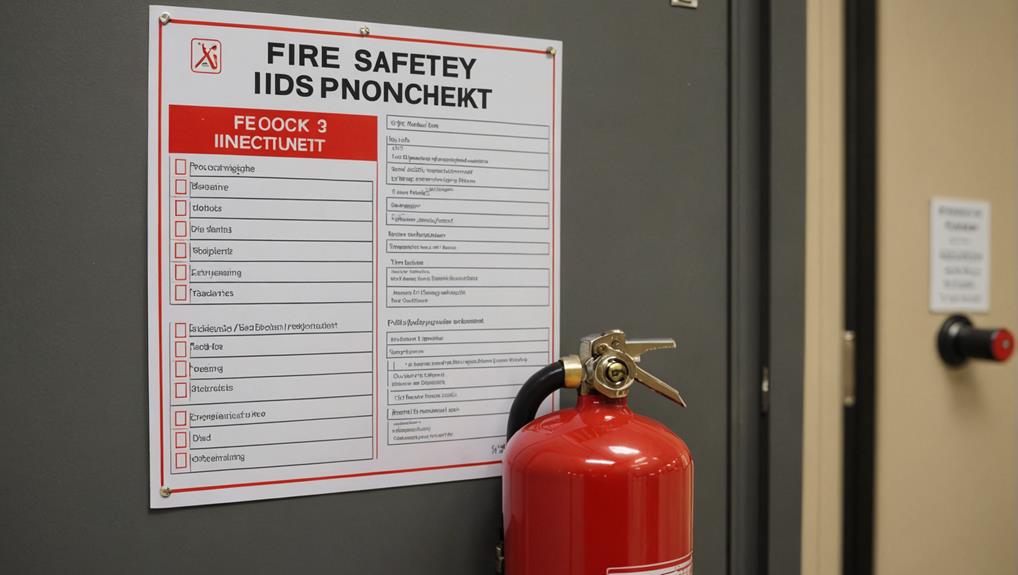
When it comes to fire safety, understanding lock standards is essential.
These standards guarantee that your locks not only function properly but also comply with regulations that protect lives and property.
Essential lock replacement is important for maintaining security and compliance.
You'll want to familiarize yourself with the significance of different lock types and their role in maintaining safety during emergencies.
Importance of Lock Standards
Lock standards play an important role in ensuring safety and security in both residential and commercial settings. By adhering to these standards, you not only protect your property but also contribute to the well-being of those around you.
Understanding lock replacement safety standards is essential, especially when it comes to lock replacement fire safety.
Here are four reasons why lock standards are necessary:
- Compliance: Following fire regulations lock replacement helps you meet legal requirements, ensuring your property is safe and secure.
- Enhanced Security: Standardized locks offer better protection against unauthorized access, safeguarding your loved ones and valuables.
- Peace of Mind: Knowing that your locks meet industry standards can alleviate concerns about safety, allowing you to focus on serving others.
- Emergency Preparedness: Proper locks can facilitate quick exits in emergencies, ensuring everyone can evacuate safely and efficiently.
Common Lock Types
Throughout history, various lock types have evolved to meet the diverse needs of security and safety. You'll find that understanding these common lock types is vital, especially when considering locks for fire safety.
Deadbolts are among the most popular locks, providing solid security by extending a metal bolt into the door frame. They're often recommended for external doors to enhance safety.
Knob locks, while convenient, are less secure on their own and should ideally be paired with a deadbolt for better protection.
For those focused on fire safety, consider using locks that comply with fire-rated standards. These locks can withstand high temperatures, ensuring that escape routes remain accessible during emergencies.
Additionally, panic bars are important in public buildings, allowing swift exit without fumbling for keys.
Lastly, electronic locks offer modern solutions, providing keyless entry and the ability to easily change codes.
When you choose the right lock, you're not just securing a space; you're also contributing to the overall safety and well-being of everyone who uses that space.
Prioritizing locks for fire safety can make a significant difference in emergency situations.
Compliance With Regulations
Understanding the compliance with fire safety regulations is essential for guaranteeing that your locks meet necessary standards.
When you prioritize safety, you protect not just your property but also the lives of those who depend on it.
Here are four key points to take into account regarding lock standards:
- Certification: Confirm your locks are certified by recognized authorities, confirming they meet fire safety requirements.
- Material: Choose locks made from fire-resistant materials to minimize hazards during a fire.
- Functionality: Select locks that allow for quick and easy exit in emergencies, as this can greatly enhance safety.
- Regular Inspections: Schedule regular checks to verify your locks remain compliant and functional over time.
Types of Compliant Locks
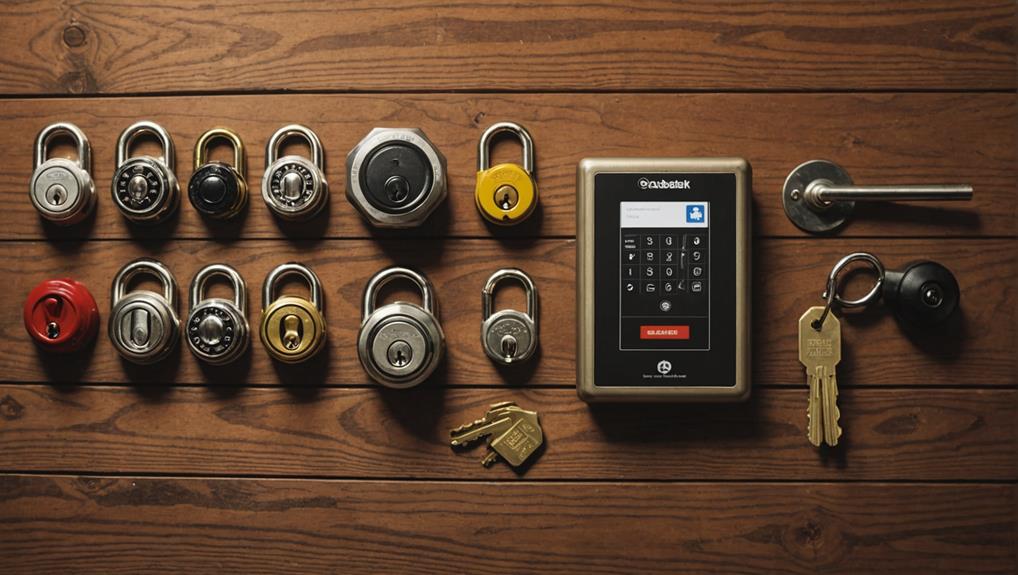
When it comes to fire safety, understanding the different types of compliant locks is vital. Compliance with building codes not only influences the selection of these locks but also guarantees they function effectively during emergencies.
You'll want to know about fire-rated lock features and how they meet compliance standards, as outlined in navigating lock replacement.
Let's explore what makes these locks essential for safeguarding safety in fire emergencies.
Lock Types Overview
Locks play an essential role in fire safety regulations, ensuring both security and compliance in various environments. Understanding the types of compliant locks can help you serve others effectively while adhering to safety standards.
Here's an overview of four key types of locks that you might consider:
- Deadbolts: These provide enhanced security by using a solid metal bolt that extends into the door frame, making unauthorized access difficult.
- Lever Handles: Often easier to operate, these locks are ideal for facilities serving the elderly or individuals with disabilities, allowing quick exits during emergencies.
- Panic Bars: Specifically designed for emergency exits, panic bars allow for immediate egress, ensuring that doors can be opened easily from the inside when seconds count.
- Magnetic Locks: These provide a high level of security and can be integrated with alarm systems, making them suitable for sensitive areas while allowing for quick evacuation.
Fire-Rated Lock Features
Fire safety regulations require specific features in locks to guarantee they perform effectively during emergencies. When you're selecting fire-rated locks, it's crucial to contemplate their ability to withstand high temperatures and prevent smoke from spreading. These features could save lives and protect property during a fire.
Here's a quick overview of essential fire-rated lock features:
| Feature | Description | Importance |
|---|---|---|
| Fire Rating | Rated for 20, 30, or 60 minutes | Guarantees adequate protection time |
| Material | Made of steel or other fire-resistant materials | Reduces risk of melting or warping |
| Self-Closing | Automatically shuts when released | Helps contain fires in specific areas |
| Smoke Seal | Prevents smoke from passing through | Protects escape routes from smoke |
Choosing compliant fire-rated locks isn't just about meeting regulations; it's about guaranteeing safety for those you serve. By investing in these features, you contribute to a safer environment, allowing people to escape danger swiftly and securely. Remember, your choices today can make a significant difference in emergency situations.
Compliance Standards Explained
Understanding compliance standards is vital for selecting the right fire-rated locks. These standards guarantee that the locks you choose not only function properly but also meet safety regulations important for protecting lives and property.
Here are four types of compliant locks you should consider:
- UL 10C Rated Locks: These locks have been tested for their ability to withstand fire and are vital for doors that serve as fire barriers.
- BHMA Certified Locks: The Builders Hardware Manufacturers Association (BHMA) certifies locks based on performance and durability, guaranteeing they meet specific safety criteria.
- NFPA Compliant Locks: Locks that adhere to the National Fire Protection Association guidelines offer peace of mind, knowing they're designed for emergency situations.
- ANSI Grade 1 Locks: These locks provide the highest level of security and are ideal for entrances that require both safety and durability.
Key Features of Fire-Safe Locks
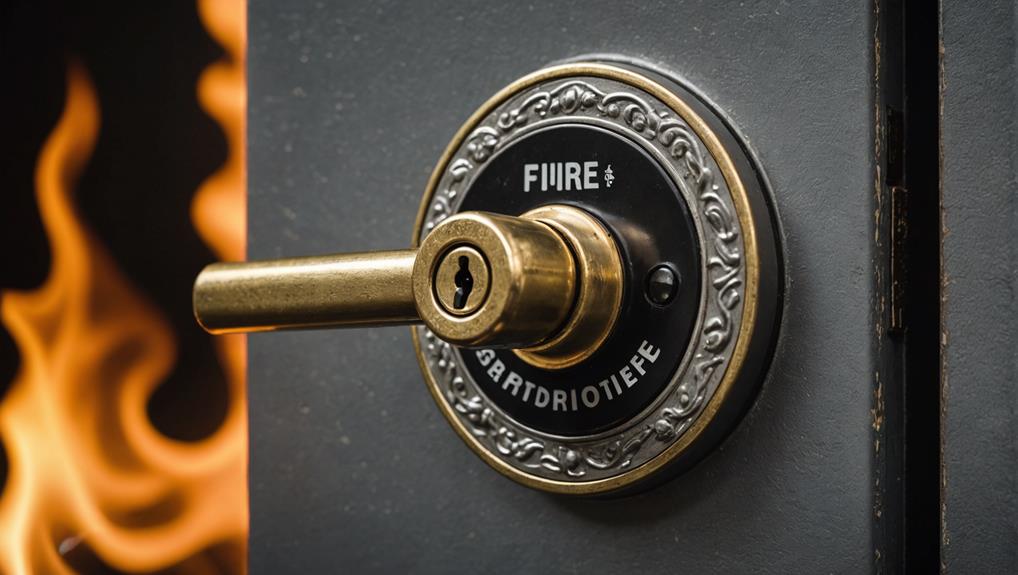
When it comes to securing your property during a fire, choosing the right type of lock is essential. Fire-safe locks come with key features that enhance safety and accessibility in emergencies.
First, these locks often use materials that can withstand high temperatures, preventing them from warping or failing during a fire. This durability guarantees that you can access exits when it matters most, which is especially critical if you consider the potential savings on security measures through options like opening savings.
Another important feature is the quick-release mechanism. This allows you to easily open the lock without fumbling during a panic, assuring a swift exit for you and those you serve.
Many fire-safe locks also include a fail-safe design, where the lock automatically disengages during a fire, eliminating the risk of being trapped inside.
Additionally, consider locks that are compliant with fire safety regulations. These often undergo rigorous testing to verify they meet safety standards, giving you peace of mind.
Lock Replacement Procedures
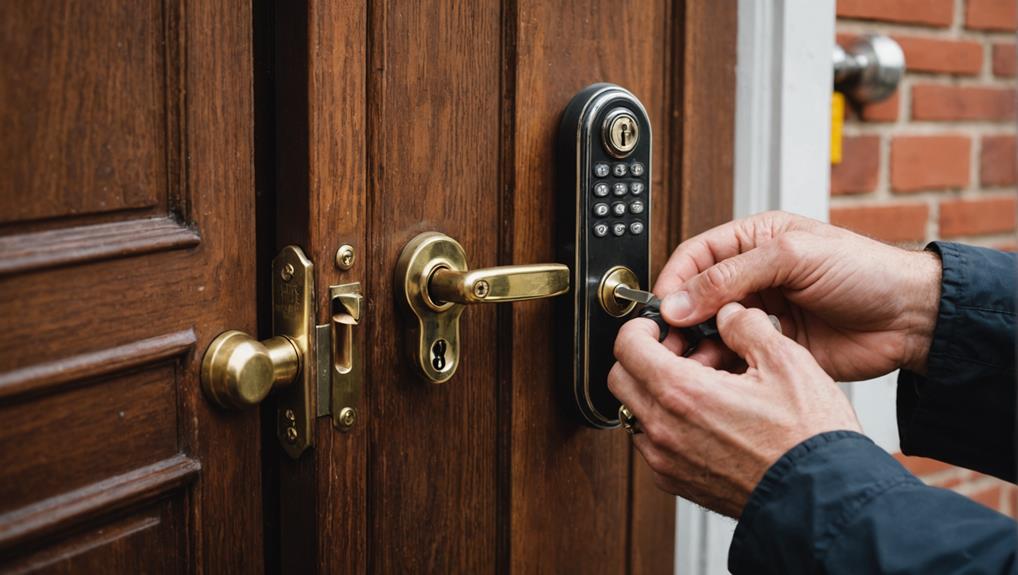
Choosing the right locks is only part of maintaining a fire-safe environment; knowing how to replace them properly is just as important.
When it comes to lock replacement, following the correct procedures can guarantee safety and compliance with fire regulations. It's also vital to take into account the type of lock you're installing, as some options may offer better security features.
Here's how you can do it effectively:
- Assess the Lock: Before you begin, evaluate the lock's condition. If it's damaged or outdated, it's time to replace it.
- Gather Tools: Have the necessary tools ready, such as a screwdriver, a replacement lock, and safety glasses.
- Remove the Old Lock: Carefully unscrew the existing lock, making sure to keep any screws and components together for easy installation of the new lock.
- Install the New Lock: Position the new lock in place, ensuring it fits snugly. Secure it using the screws you saved earlier, and test its functionality.
For more detailed guidance on lock replacement options, be sure to take into account the specific needs of your home.
Regular Maintenance and Inspections
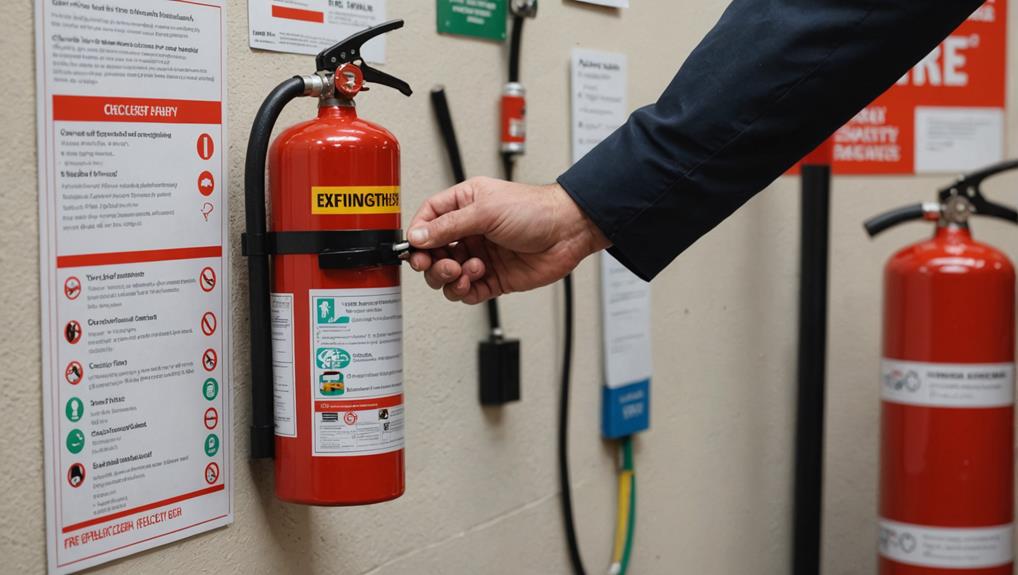
Regular maintenance and inspections are essential for guaranteeing fire safety in your environment. By routinely checking your fire safety equipment and systems, you not only protect yourself but also those you serve.
It's important to also consider the security of your premises, as emergency lock replacement costs can greatly impact your overall safety planning. Start by evaluating smoke alarms, fire extinguishers, and sprinkler systems.
Make it a habit to test alarms monthly and replace batteries at least once a year. For fire extinguishers, inspect them for visible damage and confirm they're easily accessible.
Don't forget to examine exit routes and emergency lighting. Verify exit signs are illuminated and unobstructed, guiding everyone safely out in case of an emergency.
Schedule annual inspections with certified professionals to identify any potential issues you may miss.
Additionally, keep your emergency plans updated and communicate them clearly to everyone in your environment. Regular training sessions can empower your team to respond effectively during emergencies.
Fire Codes and Building Regulations
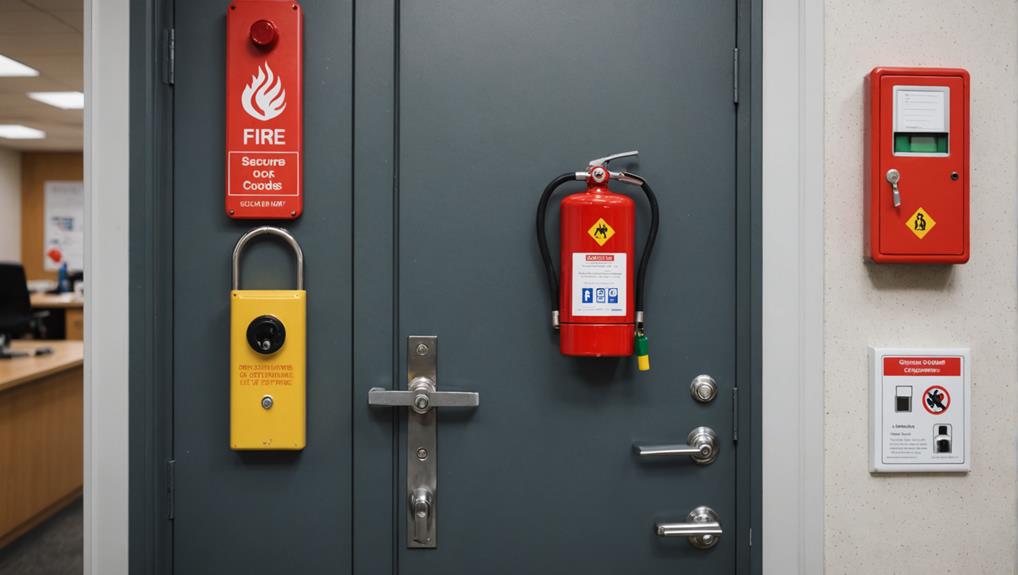
Understanding fire codes and building regulations is fundamental for guaranteeing safety in any facility. These codes are designed to protect lives and property, and you have a significant role in adhering to them. By staying informed, you help create a safer environment for everyone.
Here are four key aspects to take into account:
- Egress Routes: Confirm all exits are clearly marked and easily accessible. Regularly check that corridors are unobstructed.
- Fire Alarm Systems: Maintain and test your fire alarm systems regularly. This guarantees they function correctly in an emergency.
- Sprinkler Systems: Verify that your building's sprinkler systems comply with local codes. Regular inspections are essential for effective fire suppression.
- Fire Extinguishers: Place fire extinguishers at strategic locations throughout the facility. Make sure they're inspected and maintained as per regulations.
Choosing the Right Locks
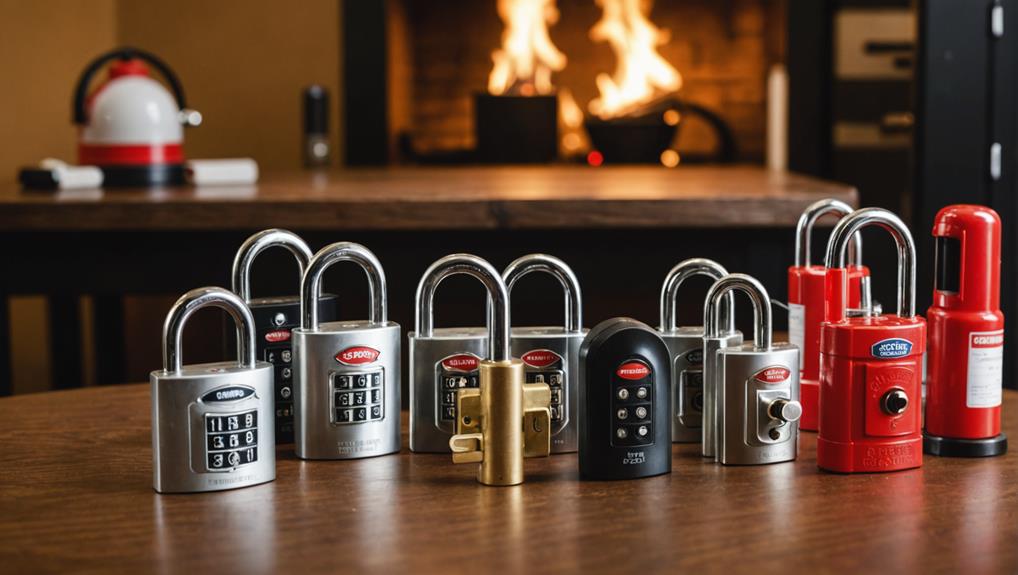
Selecting the right locks for your facility plays a significant role in overall safety and security. When you choose locks, think about their reliability, durability, and compliance with fire safety regulations. You want locks that not only secure your property but also allow for quick exits in emergencies.
Look for products that meet or exceed industry standards, guaranteeing they can withstand wear and tear while providing dependable performance. Additionally, choosing the perfect lock can enhance your overall security strategy, confirming that you aren't only compliant but also proactive in safeguarding your facility.
Reflect on the specific needs of your facility. High-traffic areas may require heavy-duty locks, while administrative offices could benefit from electronic or smart locks that offer controlled access.
Don't forget to think about the user experience; locks should be easy to operate for everyone, including those with disabilities.
Regularly assess your lock choices to verify they remain effective and safe. If you notice wear or if your locks are outdated, it's time to replace them.
Impact of Non-Compliance
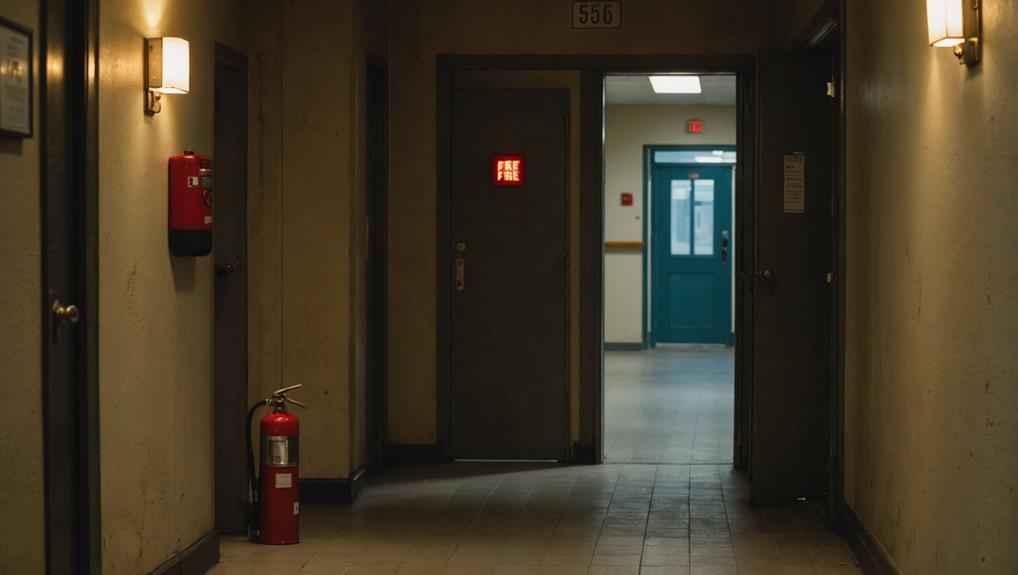
Ignoring fire safety regulations can have serious consequences for your facility. When you neglect these essential guidelines, you not only put lives at risk but also jeopardize your organization's integrity.
Additionally, the safety of your locks plays a critical role in meeting these regulations, as understanding the costs of professional lock replacement can help guarantee your facility remains compliant. Non-compliance can lead to severe repercussions that affect everyone involved.
Here are some impacts you should consider:
- Increased Liability: If an accident occurs, you may face legal actions that could drain your resources and tarnish your reputation.
- Financial Penalties: Regulatory agencies often impose hefty fines for non-compliance, straining your budget and diverting funds from your mission.
- Insurance Issues: Non-compliance can void your insurance coverage, leaving you vulnerable to significant financial loss in the event of a fire.
- Damage to Community Trust: Your commitment to safety reflects your values. Failing to adhere to regulations can erode the trust your community places in you.
Frequently Asked Questions
How Often Should Fire-Safe Locks Be Replaced?
You should consider replacing fire-safe locks every five to seven years, or sooner if you notice signs of wear or damage.
Regular inspection helps guarantee they function properly when needed.
It's important to stay proactive, as these locks play an essential role in safety during emergencies.
Keeping them in top condition not only protects your space but also shows you care about the well-being of those who rely on your environment for safety.
Are There Penalties for Non-Compliance With Fire Safety Regulations?
Yes, there're penalties for non-compliance with safety regulations. If you don't follow the rules, you might face fines or even legal action.
It's essential to stay informed and guarantee your practices meet the required standards. By doing so, you not only protect yourself but also those you serve.
Keeping everyone safe is a priority, and understanding the consequences of non-compliance helps you maintain a responsible and secure environment for all.
Can I Install Fire-Safe Locks Myself?
You can install fire-safe locks yourself, but it's essential to guarantee you do it correctly.
You'll need the right tools, clear instructions, and a good understanding of the lock's features.
You're not just enhancing security; you're protecting lives.
By taking the time to learn the process, you're serving others by creating a safer environment.
Just remember, if you're unsure, consulting a professional is always a wise choice to guarantee everything's done right.
What Materials Are Fire-Safe Locks Made From?
Fire-safe locks are typically made from materials that can withstand high temperatures, like steel or specialized alloys.
These materials help prevent the lock from failing during a fire, ensuring your safety.
You'll often find that fire-safe locks also include features like intumescent seals, which expand when heated to block smoke and heat.
Do Fire-Safe Locks Work With Existing Door Frames?
Yes, fire-safe locks can work with existing door frames, but it's vital to guarantee compatibility.
You'll want to check the lock's specifications and your door frame's dimensions. If you find a suitable match, installation should be straightforward.
However, if you're unsure, consulting a professional can help you make the best choice.
Conclusion
In the grand scheme of safety, ensuring your locks meet fire safety regulations isn't just a good idea—it's essential. By choosing compliant locks and keeping them in tip-top shape, you're not only safeguarding your space but also giving yourself peace of mind. Think of it as a cozy blanket of security wrapped around your home or business. So, don't let non-compliance sneak in; embrace the warmth of proper fire safety and lock replacement practices today!

